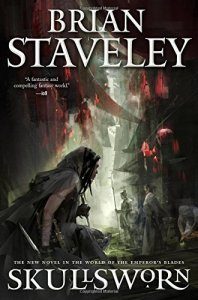Paul Di Filippo reviews Algernon Blackwood
The Face of the Earth and Other Imaginings, Algernon Blackwood, edited by Mike Ashley (Stark House 978-1933586700, $19.95, 222pp, hc) March 2015.
 If you see a book with the byline of Mike Ashley on it, as either editor or author, buy it. You won’t go wrong. Ashley is a scholar of fantastika who exhibits a populist touch and an academic’s depth of knowledge. Readability and historical importance go hand-in-hand in his spelunking through the vast untapped storehouse of forgotten fantasy, science fiction and horror. Moreover, he knows these hidden nooks and crannies of the field better than nine-tenths of the rest of us alleged experts, and can be relied on to ferret out concealed treasures. Also, he is scrupulous in his documentation and annotations.
If you see a book with the byline of Mike Ashley on it, as either editor or author, buy it. You won’t go wrong. Ashley is a scholar of fantastika who exhibits a populist touch and an academic’s depth of knowledge. Readability and historical importance go hand-in-hand in his spelunking through the vast untapped storehouse of forgotten fantasy, science fiction and horror. Moreover, he knows these hidden nooks and crannies of the field better than nine-tenths of the rest of us alleged experts, and can be relied on to ferret out concealed treasures. Also, he is scrupulous in his documentation and annotations.
Now, when you yoke Ashley to the somewhat neglected yet canonical fantasist Algernon Blackwood (1869-1951, most famous for “The Wendigo”), you know you are in for a special treat, mainly because Ashley has previously produced a book-length biography of Blackwood and inhabits this terrain especially well.
This current Ashley-compiled volume from Stark House—a superb small press which concentrates on rescuing groovy vintage noir, but which has also reprinted ten Blackwood novels and story collections previously—features rare stories and essays from the early years of Blackwood’s career. Some thirty entries in the generous table of contents preclude an item-by-item discussion, so I shall have to cite just a few of my favorites.
The initial section of the collection is “Early Tales,” and it kicks off with Blackwood’s very first piece of published fiction, from when he was a mere twenty years old. “The Mysterious House” is very creepy, and presents a youthful flair and exuberance without a lot of sophistication. But that latter quality, along with more craftsmanship, shows up pretty quickly, for Blackwood was a natural storyteller. I don’t see how else someone could make a haunted piece of luggage, for goodness’s sake, really horrific, as he does in “The Kit-Bag.” Blackwood had a knack for coining really unsettling phrases, as in this story, that expressed uncanny symptoms and phenomena. “It was a singular and curious malaise that had come over him, and he hardly knew what to make of it. He felt as though he were doing something that was strongly objected to by another person, a person, moreover, who had some right to object.” And the title story is a small masterpiece, because it leaves you in doubt right up to the end. Yes, the mad professor believed our planet was a sentient beast that demanded sacrificial victims. But just because he was possessed with this monomania, was he so very wrong?
Ashley segregates four stories into the second section under the rubric “Imagination Awakes,” because they all illuminate Blackwood’s notion of the powers of the non-mimetic mind. “Stodgman’s Opportunity” is an amusing piece about a fellow utterly devoid of that vital power of fancy. But the strongest item here is “The Night-Wind,” in which Uncle Henry, an author, summons up by his oral fairytales a deity which the children in his presence help to reify, joyfully but spookily.
Section three, “Nature Inspires,” consists of journalistic essays by Blackwood that give us further insights into the sources of his literary powers and the passions that served as the engines of his daily life. Many of them display a Thoreauvian quality, for Blackwood was in love with natural creation like that old Walden chap. “‘Mid the Haunts of the Moose” might call up comparisons to Thoreau’s The Maine Woods, with a similar mix of closely observed nature and philosophy. But “Down the Danube in a Canadian Canoe” conjures up not Thoreau, but rather the gentle idle humor of Jerome K. Jerome.
Our final segment, “Conflicts of the Soul,” is a mix of fiction and non-fiction which surveys a sea-changed Blackwood who emerged from the horrors of World War I as a semi-shattered man and had to rebuild his soul. The standout item here is the story “Onanonanon.” In a very compact space, we get a seminal and semi-mystical childhood incident recounted in hallucinatory detail. Then we jump ahead by several decades to the recurrence of the incident, with mortal variations. If you were to read this story in, say, Lady Churchill’s Rosebud Wristlet, you would think it utterly congruent with Kelly Link’s own postmodern fiction, and acclaim it as the work of some hot new millennial fabulist.
With a fair shake, this collection should drive thousands of readers to seek out Blackwood’s mature work, rewarding the efforts and faith of both Ashley and Stark House, whilst procuring much reading pleasure for themselves.




